TOYOTA HIGHLANDER HYBRID 2006 XU40 / 2.G Owners Manual
Manufacturer: TOYOTA, Model Year: 2006, Model line: HIGHLANDER HYBRID, Model: TOYOTA HIGHLANDER HYBRID 2006 XU40 / 2.GPages: 436, PDF Size: 8.76 MB
Page 321 of 436
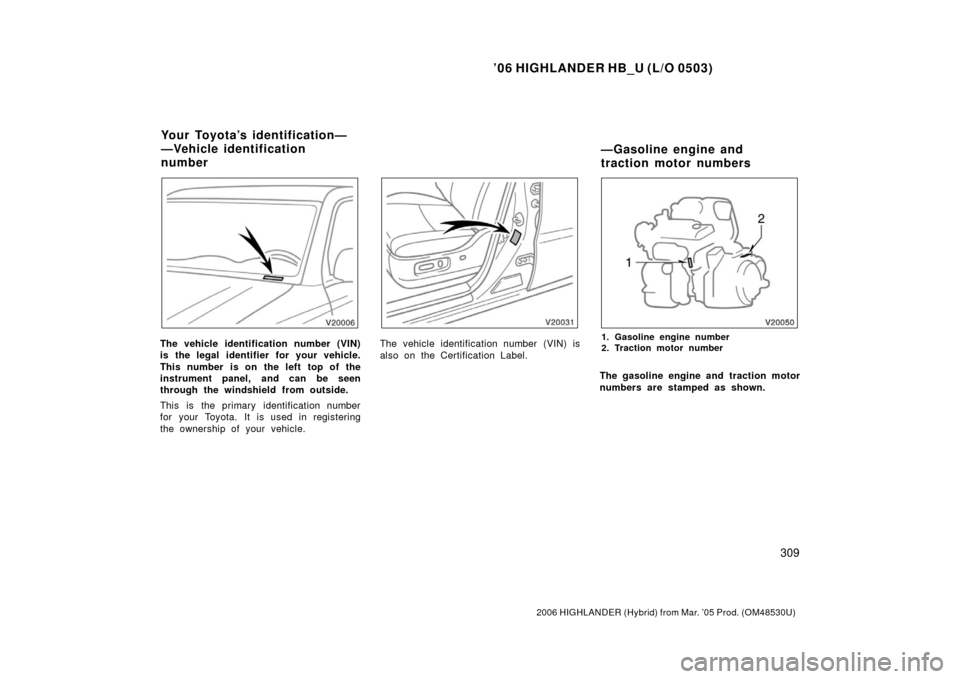
’06 HIGHLANDER HB_U (L/O 0503)
309
2006 HIGHLANDER (Hybrid) from Mar. ’05 Prod. (OM48530U)
The vehicle identification number (VIN)
is the legal identifier for your vehicle.
This number is on the left top of the
instrument panel, and can be seen
through the windshield from outside.
This is the primary identification number
for your Toyota. It is used in registering
the ownership of your vehicle.The vehicle identification number (VIN) is
also on the Certification Label.1. Gasoline engine number
2. Traction motor number
The gasoline engine and traction motor
numbers are stamped as shown.
Your Toyota’s identification—
—Vehicle identification
number —Gasoline engine and
traction motor numbers
Page 322 of 436
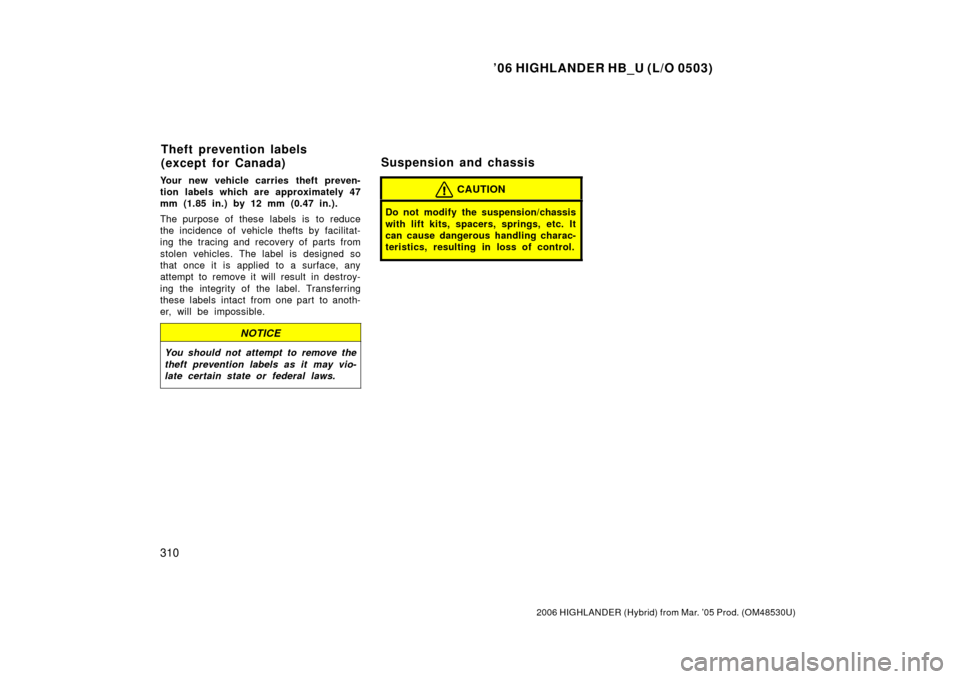
’06 HIGHLANDER HB_U (L/O 0503)
310
2006 HIGHLANDER (Hybrid) from Mar. ’05 Prod. (OM48530U)
Your new vehicle carries theft preven-
tion labels which are approximately 47
mm (1.85 in.) by 12 mm (0.47 in.).
The purpose of these labels is to reduce
the incidence of vehicle thefts by facilitat-
ing the tracing and recovery of parts from
stolen vehicles. The label is designed so
that once it is applied to a surface, any
attempt to remove it will result in destroy-
ing the integrity of the label. Transferring
these labels intact from one part to anoth-
er, will be impossible.
NOTICE
You should not attempt to remove the
theft prevention labels as it may vio-
late certain state or federal laws.
CAUTION
Do not modify the suspension/chassis
with lift kits, spacers, springs, etc. It
can cause dangerous handling charac-
teristics, resulting in loss of control.
Theft prevention labels
(except for Canada) Suspension and chassis
Page 323 of 436
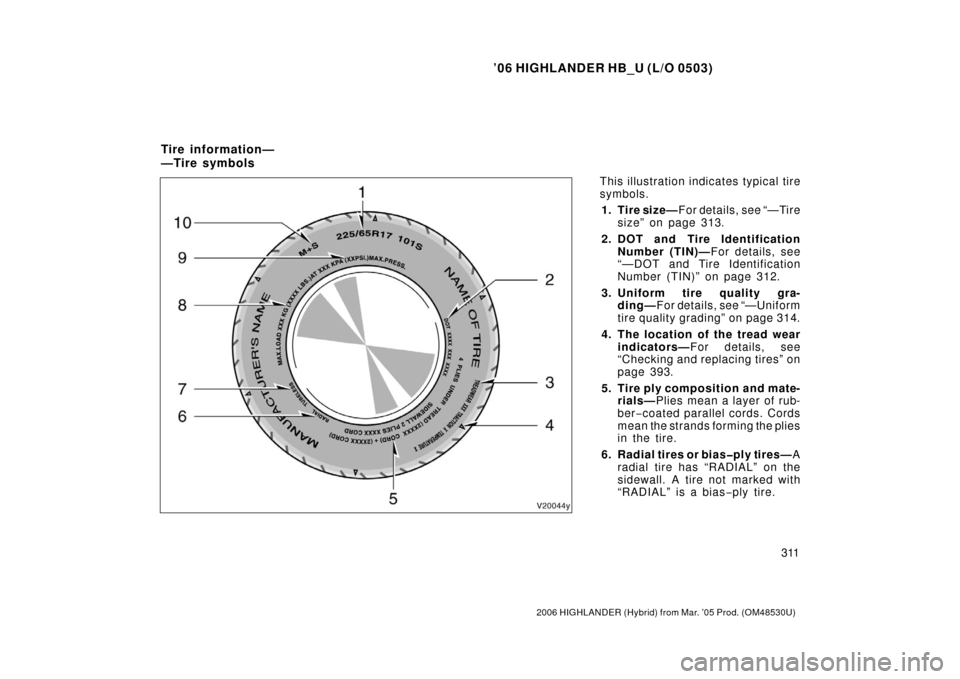
’06 HIGHLANDER HB_U (L/O 0503)
311
2006 HIGHLANDER (Hybrid) from Mar. ’05 Prod. (OM48530U)
This illustration indicates typical tire
symbols.
1. Tire size— F or det ails, see “— Ti re
size” on page 313.
2. DOT and Tire Identification Number (TIN)— For details, see
“—DOT and Tire Identification
Number (TIN)” on page 312.
3. Uniform tire quality gra- ding— For details, see “—Uniform
tire quality grading” on page 314.
4. The location of the tread wear indicators— For details, see
“Checking and replacing tires” on
page 393.
5. Tire ply composition and mate- rials— Plies mean a layer of rub-
ber −coated parallel cords. Cords
mean the strands forming the plies
in the tire.
6. Radial tires or bias�ply tires— A
radial tire has “RADIAL” on the
sidewall. A tire not marked with
“RADIAL” is a bias −ply tir e.
Tire information—
—Tire symbols
Page 324 of 436
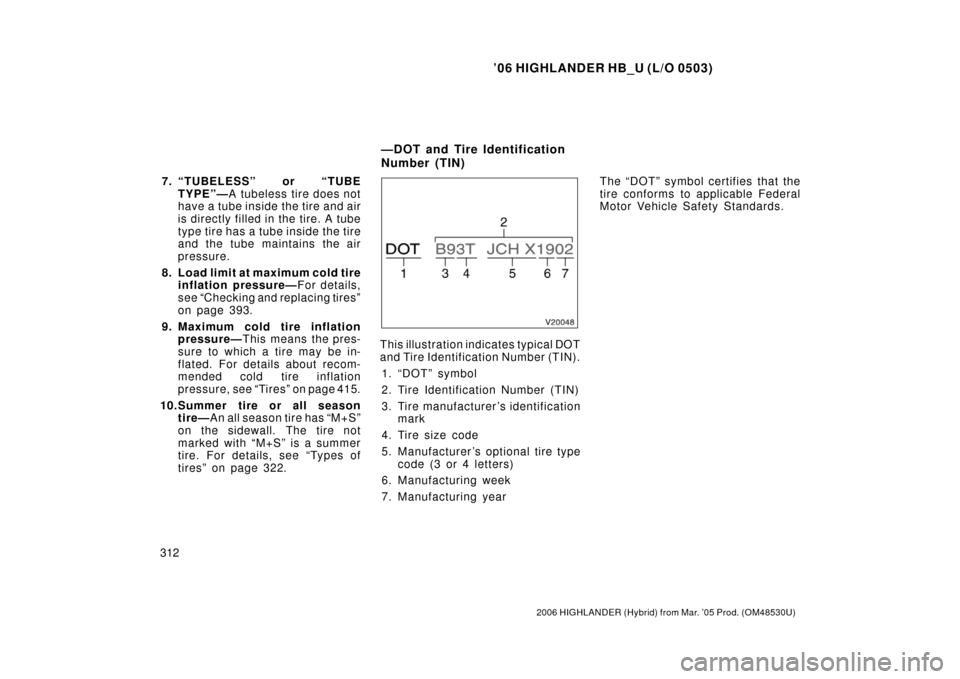
’06 HIGHLANDER HB_U (L/O 0503)
312
2006 HIGHLANDER (Hybrid) from Mar. ’05 Prod. (OM48530U)
7. “TUBELESS” or “TUBE
TYPE”— A tubeless tire does not
have a tube inside the tire and air
is directly filled in the tire. A tube
type tire has a tube inside the tire
and the tube maintains the air
pressure.
8. Load limit at maximum cold tire inflation pressure— For details,
see “Checking and replacing tires”
on page 393.
9. Maximum cold tire inflation pressure— This means the pres-
sure to which a tire may be in-
flated. For details about recom-
mended cold tire inflation
pressure, see “Tires” on page 415.
10.Summer tire or all season tire— An all season tire has “M+S”
on the sidewall. The tire not
marked with “M+S” is a summer
tire. For details, see “Types of
tires” on page 322.
This illustration indicates typical DOT
and Tire Identification Number (TIN).
1. “DOT” symbol
2. Tire Identification Number (TIN)
3. Tire manufacturer ’s identification mark
4. Tire size code
5. Manufacturer ’s optional tire type code (3 or 4 letters)
6. Manufacturing week
7. Manufacturing year The “DOT” symbol certifies that the
tire conforms to applicable Federal
Motor Vehicle Safety Standards.
—DOT and Tire Identification
Number (TIN)
Page 325 of 436
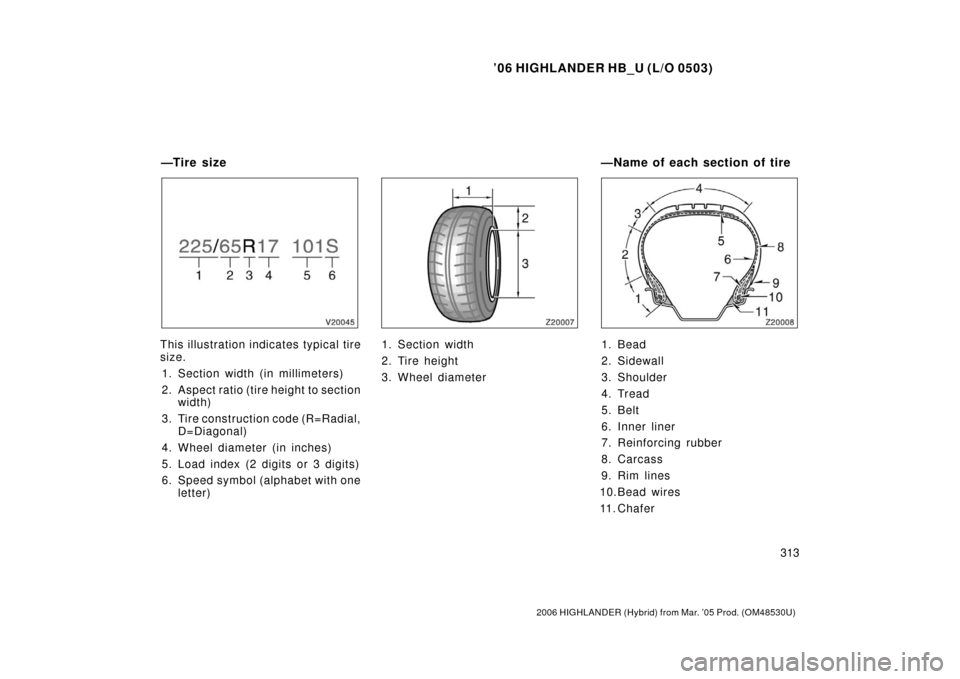
’06 HIGHLANDER HB_U (L/O 0503)
313
2006 HIGHLANDER (Hybrid) from Mar. ’05 Prod. (OM48530U)
This illustration indicates typical tire
size.
1. Section width (in millimeters)
2. Aspect ratio (tire height to section width)
3. Tire construction code (R=Radial, D=Diagonal)
4. Wheel diameter (in inches)
5. Load index (2 digits or 3 digits)
6. Speed symbol (alphabet with one letter)1. Section width
2. Tire height
3. Wheel diameter1. Bead
2. Sidewall
3. Shoulder
4. Tread
5. Belt
6. Inner liner
7. Reinforcing rubber
8. Carcass
9. Rim lines
10.Bead wires
11. Chafer
—Tire size —Name of each section of tire
Page 326 of 436

’06 HIGHLANDER HB_U (L/O 0503)
314
2006 HIGHLANDER (Hybrid) from Mar. ’05 Prod. (OM48530U)
This information has been prepared
in accordance with regulations issued
by the National Highway Traffic Safe-
ty Administration of the U.S. Depart-
ment of Transportation. It provides
the purchasers and/or prospective
purchasers of Toyota vehicles with in-
formation on uniform tire quality grad-
ing.
Your Toyota dealer will help answer
any questions you may have as you
read this information.
DOT quality grades—All passenger
vehicle tires must conform to Fed-
eral Safety Requirements in addi-
tion to these grades. Quality
grades can be found where appli-
cable on the tire sidewall between
tread shoulder and maximum sec-
tion width. For example: Treadwear
200 Traction AA Temperature A Treadwear—
The treadwear grade is
a comparative rating based on the
wear rate of the tire when tested un-
der controlled conditions on a speci-
fied government test course. For ex-
ample, a tire graded 150 would wear
one and a half (1 −1/2) times as well
on the government course as a tire
graded 100. The relative performance
of tires depends upon the actual
conditions of their use, however, and
may depart significantly from the
norm due to variations in driving hab-
its, service practices and differences
in road characteristics and climate. Traction AA, A, B, C—
The traction
grades, from highest to lowest, are
AA, A, B, and C, and they represent
the tire’s ability to stop on wet pave-
ment as measured under controlled
conditions on specified government
test surfaces of asphalt and concrete.
A tire marked C may have poor trac-
tion performance.
Warning: The traction grade assigned
to this tire is based on braking
(straight ahead) traction tests and
does not include cornering (turning)
traction.
—Uniform tire quality grading
Page 327 of 436

’06 HIGHLANDER HB_U (L/O 0503)
315
2006 HIGHLANDER (Hybrid) from Mar. ’05 Prod. (OM48530U)
Temperature A, B, C—T he tem per a-
ture grades are A (the highest), B,
and C, representing the tire’s resis-
tance to the generation of heat and
its ability to dissipate heat when
tested under controlled conditions on
a specified indoor laboratory test
wheel. Sustained high temperature
can cause the material of the tire to
degenerate and reduce tire life, and
excessive temperature can lead to
sudden tire failure. The grade C cor-
responds to a level of performance
which all passenger car tires must
meet under the Federal Motor Vehicle
Safety Standard No.109. Grades B
and A represent higher levels of per-
formance on the laboratory test wheel
than the minimum required by law.
Warning: The temperature grades for
this tire are established for a tire that
is properly inflated and not over-
loaded. Excessive speed, underinfla-
tion, or excessive loading, either sep-
arately or in combination, can cause
heat buildup and possible tire failure.
Page 328 of 436

’06 HIGHLANDER HB_U (L/O 0503)
316
2006 HIGHLANDER (Hybrid) from Mar. ’05 Prod. (OM48530U)
Ti r e relat ed ter mMeaning
Accessory weight
the combined weight (in excess of those standard items which may be
replaced) of transaxle, power steering, power brakes, power windows,
power seats, radio, and heater, to the extent that these items are available
as factory−installed equipment (whether installed or not)
Cold tire inflation pressure
tire inflation pressure when the vehicle has been parked for at least 3
hours or more, or it has not been driven more than 1.5 km or 1 mile
under that condition
Curb weight
the weight of a motor vehicle wi th standard equipment including the
maximum capacity of fuel, oil, and coolant, and, if so equipped, air
conditioning and additional weight optional engine
Intended outboard sidewall
(A) the sidewall that contains a whitewall, bears white lettering or bears manufacturer, brand, and/or model name molding that is higher or
deeper than the same molding on th e other sidewall of the tire, or
(B) the outward facing sidewall of an asymmetrical tire that has a particular side that must always face outward when mounted on a vehicle
Maximum inflation pressurethe maximum cold inflation pressure to which a tire may be inflated and it
is shown on the sidewall of the tire
Maximum loaded vehicle weight
t he sum of —
(a) curb weight;
(b) accessory weight;
(c) vehicle capacity weight; and
(d) production options weight
—Glossary of tire terminology
Page 329 of 436

’06 HIGHLANDER HB_U (L/O 0503)
317
2006 HIGHLANDER (Hybrid) from Mar. ’05 Prod. (OM48530U)
Ti r e relat ed ter mMeaning
Normal occupant weight68 kg (150 lb.) times the number of occupants specified in the second
column of Table 1 that follows
Occupant distributiondistribution of occupants in a vehicle as specified in the third column of Table
1 that follows
Production options weight
the combined weight of those installed regular production options weighing
over 2.3 kg (5 lb.) in excess of those standard items which they replace,
not previously considered in curb weight or accessory weight, including
heavy duty brakes, ride levelers, roof rack, heavy duty battery, and special
trim
Recommended inflation pressurecold tire inflation pressure recommended by a manufacturer
Rima metal support for a tire or a tire and tube assembly upon which the tire beads
are seated
Rim diameter (Wheel diameter)nominal diameter of the bead seat
Rim size designationrim diameter and width
Rim type designationthe industry of manufacturer ’s designation for a rim by style or code
Rim widt hnominal distance between rim flanges
Vehicle capacity weight
(Total load capacity)the rated cargo and luggage load plus 68 kg (150 lb.) times the vehicle’s desig-
nated seating capacity
Vehicle maximum load on the tirethe load on an individual tire that is determined by distributing to each axle
its share of the maximum loaded vehicle weight and dividing by two
Page 330 of 436

’06 HIGHLANDER HB_U (L/O 0503)
318
2006 HIGHLANDER (Hybrid) from Mar. ’05 Prod. (OM48530U)
Ti r e relat ed ter mMeaning
Vehicle normal load on the tire
the load on an individual tire that is determined by distributing to each axle
its share of the curb weight, accesso ry weight, and normal occupant weight
(distributed in accordance with Table 1 that follows) and dividing by two
Weather sidethe surface area of the rim no t covered by the inflated tire
Table 1—Occupant loading and distribution for vehicle normal load for various designated seating capacities
Designated seating capacity,number of occupants
Vehicle normal load, number of occupantsOccupant distribution in a normallyloaded vehicle
2 through 422 in front
5 through 1032 in front, 1 in second seat